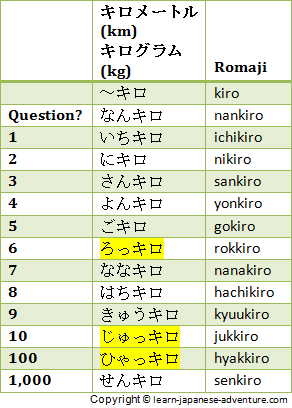- Home
- Japanese Numbers
- Japanese Counters
Different Japanese Counters
in Japanese Numbers
As mentioned before there are many Japanese counters used to count Japanese numbers for different objects.
A counter acts as an indicator to show what kind of object you are counting. You can consider that counters are used to group similar objects.
In English when you are counting object like shirt, you will say one shirt, two shirts, and so on. However in Japanese, the counter for flat and thin objects like shirt and paper is まい (mai). So you will say シャツにまい (sha tsu ni mai) for two shirts.
The counter for long and round objects is ほん (hon). Therefore you will say かさよんほん (ka sa yon hon) for four umbrellas. But in English you always say four umbrellas.
You might think that the Japanese counters are redundant. But let's think from a different perspective, you can possibly imagine what type of objects you will be counting by using counters.
Let say someone told you he saw a rare animal in the zoo. Although he told you the name of the animal, you won't be able to know what it looks like because you have not seen that animal before.
If he used the counter word 頭 (tou), you know that this is a big animal like horse or elephant. If he used the counter word 匹 (hiki), you know the animal is smaller in size, like a cat or dog.
Therefore don't reject the idea of using counters in Japanese. You will see that they are quite useful when you study further.
It is impossible to list all the counters here but I will show some common counters with pronunciations in romaji given.
Tables for Different Counters in Japanese Numbers
1. Counter for Money
 Counter for Money
Counter for MoneyThe table above shows the counter for money. Take note that you should say よえん (yoen) for four yen, not よんえん (yonen).
2. Counter for Flat and Thin Objects
 Counter for Flat and Thin Objects
Counter for Flat and Thin Objects3. Counter for Vehicles and Big Equipment
 Counter for Vehicles and Big Equipment
Counter for Vehicles and Big Equipment4. Counter for Kilometer and Kilogram
 Counter for Kilometer and Kilogram
Counter for Kilometer and KilogramThe table above shows the counter for kilometer and kilogram. Take note of the different pronunciations required for the highlighted numbers.
5. Counter for Books
 Counter for Books
Counter for BooksThe table above shows the counter for books. Take note of the different pronunciations required for the highlighted numbers.
6. Counter for Shoes and Socks
 Counter for Shoes and Socks
Counter for Shoes and SocksThe table above shows the counter for shoes and socks. Take note of the different pronunciations required for the highlighted numbers.
7. Counter for Animals
 Counters for Animals
Counters for AnimalsThe table above shows the Japanese counters for animals. Different counter words are used for big and small animals. Take note of the different pronunciations required for the highlighted numbers.
8. Counter for Long and Round Objects
 Counter for Long and Round Objects
Counter for Long and Round ObjectsThe table above shows the counter for long and round objects. Take note of the different pronunciations required for the highlighted numbers.
9. Counter for Drinks
 Counter for Drinks
Counter for DrinksThe table above shows the counter for drinks. Take note of the different pronunciations required for the highlighted numbers.
10. Counter for Floor
 Counter for Floor
Counter for FloorThe table above shows the counter for floor. Take note of the different pronunciations required for the highlighted numbers.
11. Counter for People
 Counter for People
Counter for PeopleThe table above shows the counter for people. Take note of the different pronunciations required for the highlighted numbers.
12. Counter for Small Objects
 Counter for Small Objects
Counter for Small ObjectsThe table above shows the Japanese counter for small objects. Take note of the different pronunciations required for the highlighted numbers.
As you can see, in many cases you are required to pronounce differently for number 1, 3, 6, 8, 10 and 100, etc.
However the different pronunciations are not always fixed for these numbers. Therefore you will have to memorize them for different counters.
After study them for some times, I am sure somehow you will know which number required different pronunciation for different counters.
Special Japanese Numbers
 Special Japanese Numbers
Special Japanese NumbersThe table above shows another way of counting without using any counter which I mentioned earlier.
However, you probably need to mention the counter somewhere in other sentences so that people know what you are referring to. Take note of the different pronunciations for number one to ten.
Black Friday Sale! Get 55% OFF on Basic, Premium & Premium PLUS plans! Ends on 29 Nov 2025
The link above is an affiliate link, which means that I would earn a commission (at no extra cost to you) if you do end up purchasing the related learning course.








Facebook Comments
Don’t see the comments box? Log in to your Facebook account, give Facebook consent, then return to this page and refresh it.